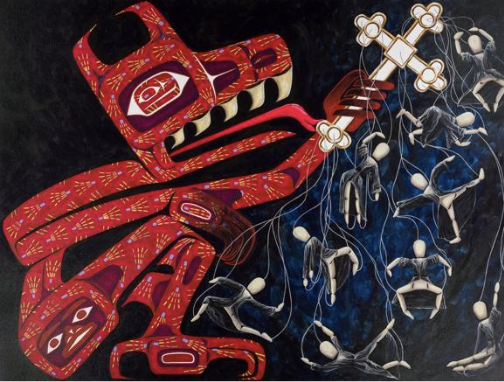
- Details
- By Native News Online Staff
Yesterday, New York City’s American Museum of Natural History unveiled a new rotating exhibit featuring works from five contemporary Indigenous artists from Canada and Alaska.
Grounded by Our Roots, the exhibit containing 13 works was guest curated by Aliya Boubard (Sagkeeng First Nation) and is featured in the museum’s Northwest Coast Hall. The Hall received a complete overhaul in 2022 after five years of consultation and reinterpretation with Pacific Northwest Tribal Nations to better incorporate Indigenous perspectives and focus on living cultures.
Museum President Sean Decatur said that the Northwest Coast Hall was designed to incorporate special temporary exhibits like Grounded by Our Roots “as part of our commitment to ensuring that contemporary Native art and perspectives are always part of the hall.”
Boubard said that the artists in the exhibit exemplify the movement of contemporary Indigenous art inspired by their ancestors.
“The mid-1900s saw the rise of contemporary Indigenous art across North America,” she said. “No longer was art confined to regalia, wood carvings, or ceremonial objects—it began to appear in silkscreen prints, contemporary sculptures, modern fashion, and other forms. Fast-forward to today, and we see incredible works from contemporary Indigenous artists who are deeply inspired by those who came before.”
The artists featured in the exhibit include Hawilkwalał Rebecca Baker-Grenier (Kwakiuł, Musgamagw Dzawada’enuxw, Sḵwx̱wú7mesh); Alison Bremner Naxhshagheit (Tlingit); SGidGang.Xaal Shoshannah Greene (Haida); Nash’mene’ta’naht Atheana Picha (Kwantlen First Nation); and Eliot White-Hill Kwulasultun (Snuneymuxw First Nation).
Simultaneous with its new exhibit, the museum is in the midst of a major ethical awakening to address the more than 12,000 human remains—about 2,200 of which are Native American ancestors— it currently holds in its collection. Human remains came to the museum from archeological expeditions, private collectors, and local medical schools that used bodies of deceased individuals for anatomical study, according to museum president Decatur.
On Oct. 12, 2023, President Decatur announced policy changes to staff in an open letter. Immediate changes included preparing new storage for the remains in the museum’s collection and removing human remains—such as human bones, skeletons, mummies, and beads and instruments made from human bones—from 12 display cases.
The museum now acknowledges an ethical obligation to return all human remains in its collection, but it’s been under a federal order to do so for the 2,200 Native American ancestors it’s held captive for more than 30 years.
The law, the Native American Graves Protection and Repatriation Act (NAGPRA) passed by Congress in 1990, required museums and federal institutions that possessed Native American human remains and their burial objects to catalog and return those ancestors and belongings within five years.
Like many institutions throughout the country, the American Museum of Natural History has been slow to make good on NAGPRA. Over the law’s 33 years, the museum has returned close to 1,000 Native ancestors, according to Decatur.
More Stories Like This
Watermark Art Center to Host “Minwaajimowinan — Good Stories” ExhibitionMuseums Alaska Awards More Than $200,000 to 12 Cultural Organizations Statewide
Zuni Youth Enrichment Project Takes Top Emerging Artist Apprentices to Phoenix for Artistic Exploration and Cultural Immersion
From Dishwasher to Award-Winning Chef: Laguna Pueblo's Josh Aragon Serves Up Albuquerque's Best Green Chile Stew
Rob Reiner's Final Work as Producer Appears to Address MMIP Crisis
Help us defend tribal sovereignty.
At Native News Online, our mission is rooted in telling the stories that strengthen sovereignty and uplift Indigenous voices — not just at year’s end, but every single day.
Because of your generosity last year, we were able to keep our reporters on the ground in tribal communities, at national gatherings and in the halls of Congress — covering the issues that matter most to Indian Country: sovereignty, culture, education, health and economic opportunity.
That support sustained us through a tough year in 2025. Now, as we look to the year ahead, we need your help right now to ensure warrior journalism remains strong — reporting that defends tribal sovereignty, amplifies Native truth, and holds power accountable.
 The stakes couldn't be higher. Your support keeps Native voices heard, Native stories told and Native sovereignty defended.
The stakes couldn't be higher. Your support keeps Native voices heard, Native stories told and Native sovereignty defended.
Stand with Warrior Journalism today.
Levi Rickert (Potawatomi), Editor & Publisher


